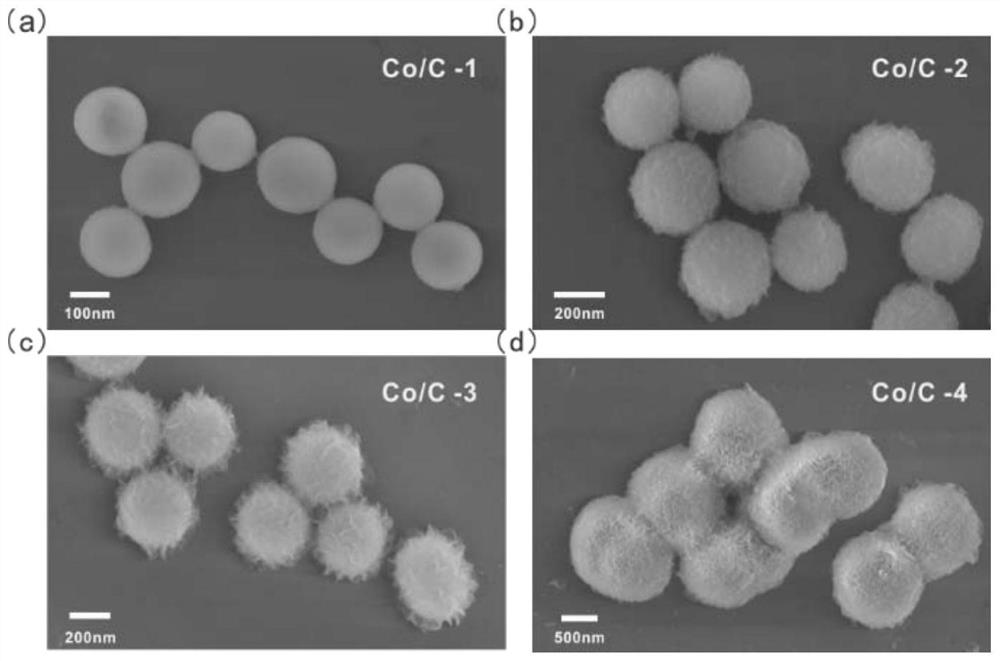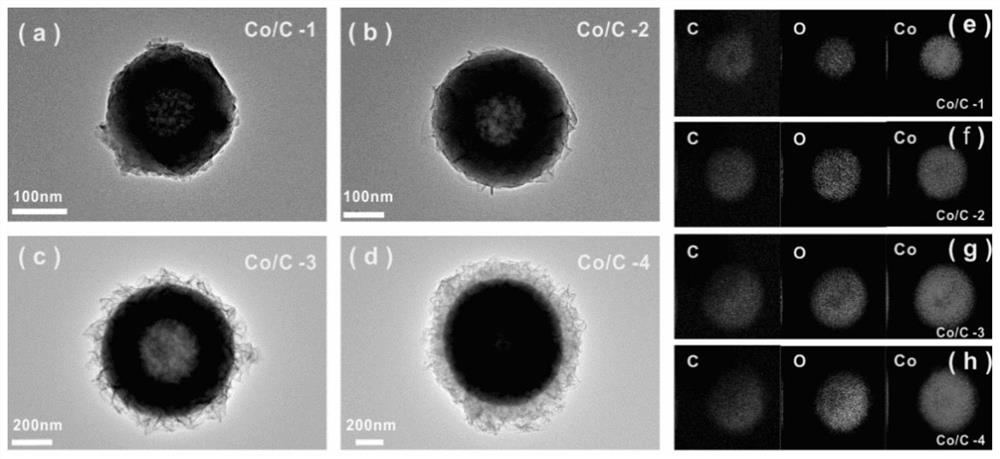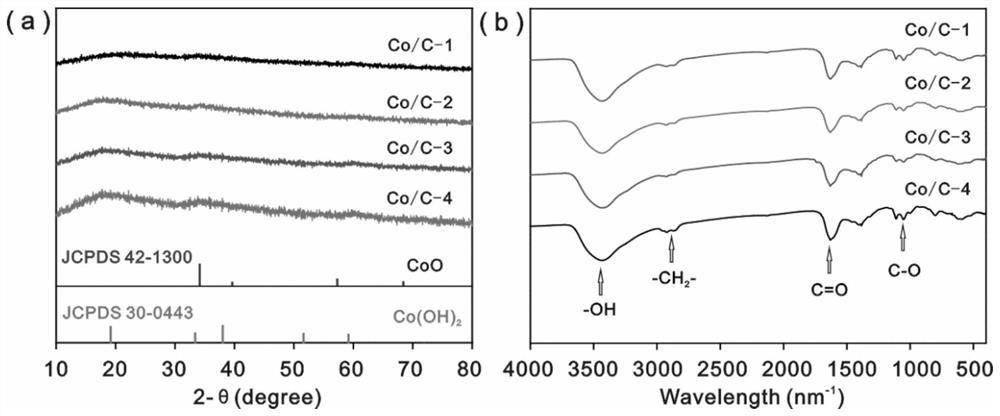Hollow amorphous cobalt carbide Fenton catalyst, and preparation method and application thereof
A carbide-based, amorphous technology, applied in the field of hollow amorphous cobalt carbide-based Fenton catalyst and its preparation, can solve the problems of low singlet oxygen generation efficiency and the like
- Summary
- Abstract
- Description
- Claims
- Application Information
AI Technical Summary
Problems solved by technology
Method used
Image
Examples
Embodiment 1
[0034] Step 1: First take 80mL of isopropanol, add 0.75mmol of cobalt nitrate hexahydrate, 0.25mmol of glucose monohydrate, and 16mL of glycerin in sequence, and stir the mixed solution for 0.5h at a speed of 600-800rpm to obtain a dark purple solution.
[0035] Step 2: Transfer the above dark purple solution to a 150mL reactor, react at 180°C for 6h, wash the product three times with water and ethanol, and then dry it at 60°C for 12h to obtain hollow amorphous cobalt carbides Co / C-3 Fenton catalyst.
[0036] The above-mentioned Co / C-3 catalyst has been characterized by scanning and transmission electron microscopy for its morphology and element distribution. It can be seen that it has an obvious hollow structure and a large number of wrinkled nanosheets on the surface. The three elements of cobalt, carbon, and oxygen are evenly distributed; and the ratio is 12.45:40.34:47.21. The amorphous phase state can be confirmed by X-ray diffractometer, and cobalt does not form obvious...
Embodiment 2
[0039] Step 1: Take 80mL of isopropanol, add 0.25mmol of cobalt nitrate hexahydrate, 0.25mmol of glucose monohydrate, and 16mL of glycerin in sequence, and stir the mixed solution for 0.5 hours at a speed of 600-800rpm to obtain a lavender solution.
[0040] Step 2: Transfer the above lavender solution to a 150mL reactor, react at 180°C for 6h, wash the obtained product three times with water and ethanol, and then dry at 60°C for 12h to obtain hollow amorphous cobalt carbide Co / C-1 Fenton catalyst.
[0041] The above-mentioned Co / C-1 catalyst was characterized by scanning and transmission electron microscopy for its morphology and element distribution. It can be seen that it has an obvious hollow structure, the surface is relatively smooth, and the three elements of cobalt, carbon, and oxygen are evenly distributed; and the ratio is 8.89:51.15:39.96 . Its amorphous phase state can be confirmed by X-ray diffractometer. Fourier transform infrared spectroscopy shows that there ...
Embodiment 3
[0044] Step 1: First take 80mL of isopropanol, add 0.50mmol of cobalt nitrate hexahydrate, 0.25mmol of glucose monohydrate, and 16mL of glycerin in sequence, and stir the mixed solution for 0.5h at a speed of 600-800rpm to obtain a purple solution.
[0045] Step 2: Transfer the above purple solution to a 150mL reactor, react at 180°C for 6h, wash the obtained product three times with water and ethanol, and then dry at 60°C for 12h to obtain a hollow amorphous cobalt carbide Co / C-2-like Fenton catalyst.
[0046] The above-mentioned Co / C-2 catalyst was characterized by scanning and transmission electron microscopy for its morphology and element distribution. It can be seen that it has an obvious hollow structure and a small amount of wrinkled nanosheets on the surface. The three elements of cobalt, carbon, and oxygen are evenly distributed; and the ratio is 10.33:41.49:48.18. Its amorphous phase state can be confirmed by X-ray diffractometer, and cobalt has no obvious crystalli...
PUM
 Login to View More
Login to View More Abstract
Description
Claims
Application Information
 Login to View More
Login to View More - R&D
- Intellectual Property
- Life Sciences
- Materials
- Tech Scout
- Unparalleled Data Quality
- Higher Quality Content
- 60% Fewer Hallucinations
Browse by: Latest US Patents, China's latest patents, Technical Efficacy Thesaurus, Application Domain, Technology Topic, Popular Technical Reports.
© 2025 PatSnap. All rights reserved.Legal|Privacy policy|Modern Slavery Act Transparency Statement|Sitemap|About US| Contact US: help@patsnap.com



